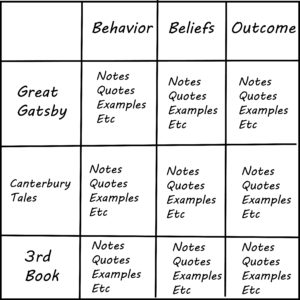Do you struggle to write the perfect answer for your essay prompts?
A number of my clients get really stuck when they have to organize their ideas for essays, and they often say a lot without actually answering the question in the prompt.
Recently a client was having this problem, so we worked on a method for making sure that the entire prompt gets answered. Here’s what we came up with:
Don’t have time for the full video? No worries, here’s a summary:
Many clients I’ve had often answer essay prompts by talking about one or two of the answers, or just by talking about the topic without answering the specific questions. So I came up with a method to make sure that my clients answer all the essay prompt questions/components. I’m going to demonstrate this for you, so you can get a feeling for how it works.
We’re going to use the following essay prompt as an example: “Using more than one source, examine how society’s expectations impact the behavior, beliefs, and outcome of the individual’s life?” First I want to point out, that when you are finished reading an essay prompt, you want to look for the structure. You are looking for how many points do you need to answer, or how many questions is your teacher asking you? In the above example, there are 3 core components to the question that we need to address in the essay. “Using more than one source, examine how society’s expectations impact the behavior 1, beliefs 2, and outcome 3 of the individual’s life?” As you can see, I’ve outlined the 3 questions. I highly recommend that when you are reading a prompt you highlight, circle, number, or in some way identify the components of the question so you know how many points you need to address in your essay.
Next, we’re going to make a chart. Charts are nice because they give us a visual representation, and with a chart you have boxes, and if you have boxes all the boxes need to be filled in, and once all the boxes are filled in you know you are done. So we’re going to make a chart with the essay components across the top and the source material(s) down the side. Then we’re going to fill in the boxes with notes, quotes, etc so that we have the information we need to begin writing our outline.

Once the chart is done, we can see visually all the topics we need to discuss in the essay, and we have our source materials, we have the notes, quotes, or examples we need in order to begin writing our outline for the essay.
I hope you found this tip useful, and if you want more tips just like it, please consider checking out my course.
